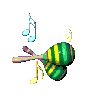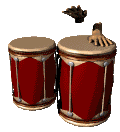
| The Latin World |


| History of the Salsa | |
| Las Raices de la Salsa | |
| The roots of Salsa | |
| Jeroen Con Sabor | |
| translated with the help of Lizzy (Los Angeles) | |
|
|



"sauce" in Spanish, is a notion where much and a few are under defeated. In the only sense, salsa is a kind of music, a modern variant of Latin-American music. In the wide side, salsa is a collective noun of various kinds of Latin-American music and dance. What means it now precisely or what are the roots of the salsa.
Sauce
Such as said before, "Salsa" means in Spanish "sauce". Cuban bands use the term too, however in order to indicate a smooth part. In much south-American music it comes in a song after a few couplets till a climax, mostly in the so-called montuno-part. This is a part of a song that has something extra, as of it’s suffuse with a delicious sauce/salsa.
Emigrants
After World War II, many Latinos under which people from Cuba, Puerto Rico, Colombia and Venezuela where going to live in the United States, most of them went to New York. Everyone took their own luggage of music. Those many kinds of music had an enormous variety of names. The Cubans have for example their Son, Guaracha, Rumba and Danzon. Later there came the popular Mambo and Cha-cha-cha. The People of Puerto Rico took their Bomba and Plena. To bring any arrangement in this jungle of terms they where looking for a collective noun that everyone understood.
New York
On which moment, its difficult to say, but on a moment the name "salsa" is accepted as the collective noun for the Latin-American rhythms. In the course of time, the term "salsa" was connecting to a definite rhythm. This was happening with the coming up of the popular music-label Fania in the early 70's in New York. Artists that fall active under the Fania-label where: Celia Cruz, Willy Colon, Tito Puente, Ruben Blades and Ismael Miranda. You can suppose that the salsa started in New York, but the biggest part is lead away of and inspirited of the Cuban music. New York is still the hottest town of salsa.
Cuba
On the island of Cuba started an extra ordinary big variety of rhythms and kinds of music. An explanation for this can be indicated many factors, such as the colonizer of this island. The Spaniards had a strong musical tradition, which they took with them to the New World. Next to it they let the slaves free to practice their own utterance of music and dance. Central into the music from the slaves of Africa was the drum and the rhythm. The Spaniards took their European instruments with them, such as guitar, piano and different kind of wind instruments. Melody played a central part of the European music. Out of this mixing of African rhythms and European melody's is started the multitude of Cuban music. Under this kind of music you find strong African kinds of music, such as the music near the religion of Yoruba and the Rumba as the more European leaded away of the Danzon, Habanera and Son.
El Son
The Son, the earl of the popular Cuban music, the Blues of Cuba is caused on the end of the 19th century in the Oriente, the region in the east of Cuba. An important city in this region is Santiago de Cuba, once the capital of Cuba. The traditional Son is played on the tres (guitar), marimbula (wooden box with metal plates) or contra-bas, bongo (two little drums) and claves (two short wooden sticks). Later joined the maracas and the trumpet. The claves gives a special rhythm. This rhythm forms the basic from almost popular Cuban dance music and the salsa from today. Big names in the traditional Son are Ignacio Pineiro, Miguel Matamores and Arsenio Rodriguez. The Son is an important manifestation of the culture of Cuba with their music, dance and poetry and is still very popular. In Santiago de Cuba, there still exist the "Casa de la Trova" where they still play the traditional Son through, for example, Quatro Patria. Another popular interpreter of the traditional Son, but with an extensive cast, is the group Sierra Maestra. The Son develops still. Artists like Alberto Alvarez and Isaac Delgado brings a more modern Son.
Salsa
The Cubans took the Son to New York. Trough pollination between other Latinos and the availability of new instruments and electronics became Son Salsa. In the movie "Las raices de la salsa" (the roots of the salsa) they where saying "Son con Son". With that they where trying to say that the salsa of today was a strong performance of the traditional Son. In essence is the rhythm of the salsa, the clave and the accents indeed the same as the Son, but still is salsa not the same. It sounds namely up on the whole different. Salsa is based on an old draft, but its music from this time. Music that played taut, they use modern recording technique, trough that it gives a nice sound. Salsa satisfies the demands of the dancers of this time and sounds like a clock, in a dance club too. The modern salsa is strong enough to take the competition with the western rock- and dance-industrial. Salsa dancing is practise in the whole world and trough the salsa cause the interest in other Latin rhythms.. It is crazy that on this moment trough the old Son the people get interest for the Salsa. Everything is an acknowledgement of the strength and the beauty of the Latin music.
Jeroen Con Sabor
|
|